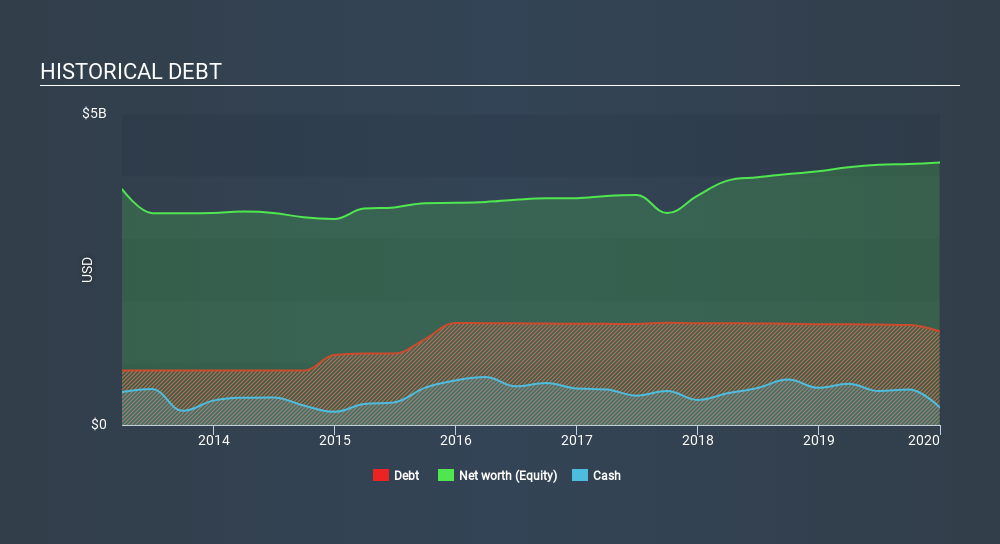- United States
- /
- Wireless Telecom
- /
- NYSE:USM
Here's Why United States Cellular (NYSE:USM) Is Weighed Down By Its Debt Load

Warren Buffett famously said, 'Volatility is far from synonymous with risk.' So it might be obvious that you need to consider debt, when you think about how risky any given stock is, because too much debt can sink a company. Importantly, United States Cellular Corporation (NYSE:USM) does carry debt. But the more important question is: how much risk is that debt creating?
What Risk Does Debt Bring?
Debt and other liabilities become risky for a business when it cannot easily fulfill those obligations, either with free cash flow or by raising capital at an attractive price. Part and parcel of capitalism is the process of 'creative destruction' where failed businesses are mercilessly liquidated by their bankers. However, a more usual (but still expensive) situation is where a company must dilute shareholders at a cheap share price simply to get debt under control. Of course, debt can be an important tool in businesses, particularly capital heavy businesses. The first step when considering a company's debt levels is to consider its cash and debt together.
Check out our latest analysis for United States Cellular
What Is United States Cellular's Net Debt?
You can click the graphic below for the historical numbers, but it shows that United States Cellular had US$1.51b of debt in December 2019, down from US$1.62b, one year before. However, it does have US$285.0m in cash offsetting this, leading to net debt of about US$1.22b.

How Strong Is United States Cellular's Balance Sheet?
Zooming in on the latest balance sheet data, we can see that United States Cellular had liabilities of US$750.0m due within 12 months and liabilities of US$3.19b due beyond that. Offsetting these obligations, it had cash of US$285.0m as well as receivables valued at US$1.06b due within 12 months. So it has liabilities totalling US$2.60b more than its cash and near-term receivables, combined.
This deficit is considerable relative to its market capitalization of US$2.62b, so it does suggest shareholders should keep an eye on United States Cellular's use of debt. Should its lenders demand that it shore up the balance sheet, shareholders would likely face severe dilution.
In order to size up a company's debt relative to its earnings, we calculate its net debt divided by its earnings before interest, tax, depreciation, and amortization (EBITDA) and its earnings before interest and tax (EBIT) divided by its interest expense (its interest cover). The advantage of this approach is that we take into account both the absolute quantum of debt (with net debt to EBITDA) and the actual interest expenses associated with that debt (with its interest cover ratio).
United States Cellular has a very low debt to EBITDA ratio of 1.5 so it is strange to see weak interest coverage, with last year's EBIT being only 1.4 times the interest expense. So while we're not necessarily alarmed we think that its debt is far from trivial. The bad news is that United States Cellular saw its EBIT decline by 13% over the last year. If that sort of decline is not arrested, then the managing its debt will be harder than selling broccoli flavoured ice-cream for a premium. When analysing debt levels, the balance sheet is the obvious place to start. But ultimately the future profitability of the business will decide if United States Cellular can strengthen its balance sheet over time. So if you want to see what the professionals think, you might find this free report on analyst profit forecasts to be interesting.
Finally, a company can only pay off debt with cold hard cash, not accounting profits. So the logical step is to look at the proportion of that EBIT that is matched by actual free cash flow. During the last three years, United States Cellular burned a lot of cash. While investors are no doubt expecting a reversal of that situation in due course, it clearly does mean its use of debt is more risky.
Our View
On the face of it, United States Cellular's interest cover left us tentative about the stock, and its conversion of EBIT to free cash flow was no more enticing than the one empty restaurant on the busiest night of the year. But at least it's pretty decent at managing its debt, based on its EBITDA,; that's encouraging. After considering the datapoints discussed, we think United States Cellular has too much debt. While some investors love that sort of risky play, it's certainly not our cup of tea. Given the risks around United States Cellular's use of debt, the sensible thing to do is to check if insiders have been unloading the stock.
Of course, if you're the type of investor who prefers buying stocks without the burden of debt, then don't hesitate to discover our exclusive list of net cash growth stocks, today.
If you spot an error that warrants correction, please contact the editor at editorial-team@simplywallst.com. This article by Simply Wall St is general in nature. It does not constitute a recommendation to buy or sell any stock, and does not take account of your objectives, or your financial situation. Simply Wall St has no position in the stocks mentioned.
We aim to bring you long-term focused research analysis driven by fundamental data. Note that our analysis may not factor in the latest price-sensitive company announcements or qualitative material. Thank you for reading.
About NYSE:USM
United States Cellular
Provides wireless telecommunications services in the United States.
Good value with moderate growth potential.
Similar Companies
Market Insights
Community Narratives





